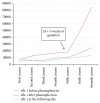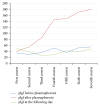Response to Plasmapheresis Measured by Angiogenic Factors in a Woman with Antiphospholipid Syndrome in Pregnancy
- PMID: 26413360
- PMCID: PMC4564609
- DOI: 10.1155/2015/123408
Response to Plasmapheresis Measured by Angiogenic Factors in a Woman with Antiphospholipid Syndrome in Pregnancy
Abstract
An imbalance of angiogenic and antiangiogenic placental factors such as endoglin and soluble fms-like tyrosine kinase 1 has been implicated in the pathophysiology of preeclampsia. Extraction of these substances by plasmapheresis might be a therapeutical approach in cases of severe early-onset preeclampsia. Case Report. A 21-year-old primigravida with antiphospholipid syndrome developed early-onset preeclampsia at 18 weeks' gestation. She was treated successfully with plasmapheresis in order to prolong pregnancy. Endoglin and sflt-1-levels were measured by ELISA before and after treatment. Endoglin levels decreased significantly after treatment (p < 0.05) and showed a significant decrease throughout pregnancy. A rerise of endoglin and sflt-1 preceded placental abruption 4 weeks before onset of incident. Conclusion. Due to the limited long-term therapeutical possibilities for pregnancies complicated by PE, plasmapheresis seems to be a therapeutical option. This consideration refers especially to pregnancies with early-onset preeclampsia, in which, after first conventional treatment of PE, prolongation of pregnancy should be above all.
Figures
Similar articles
-
Angiogenic factors in pregnancies of women with antiphospholipid syndrome and systemic lupus erythematosus.J Reprod Immunol. 2018 Jun;127:19-23. doi: 10.1016/j.jri.2018.04.002. Epub 2018 Apr 18. J Reprod Immunol. 2018. PMID: 29689494
-
First trimester serum angiogenic and anti-angiogenic factors in women with chronic hypertension for the prediction of preeclampsia.Am J Obstet Gynecol. 2020 Apr;222(4):374.e1-374.e9. doi: 10.1016/j.ajog.2019.10.101. Epub 2019 Nov 6. Am J Obstet Gynecol. 2020. PMID: 31705883
-
Angiogenic factor imbalance early in pregnancy predicts adverse outcomes in patients with lupus and antiphospholipid antibodies: results of the PROMISSE study.Am J Obstet Gynecol. 2016 Jan;214(1):108.e1-108.e14. doi: 10.1016/j.ajog.2015.09.066. Epub 2015 Sep 29. Am J Obstet Gynecol. 2016. PMID: 26432463 Free PMC article.
-
[Potential value of placental angiogenic factors as biomarkers in preeclampsia for clinical physicians].Nephrol Ther. 2019 Nov;15(6):413-429. doi: 10.1016/j.nephro.2018.10.005. Epub 2019 Mar 30. Nephrol Ther. 2019. PMID: 30935786 Review. French.
-
New insights into the etiology of preeclampsia: identification of key elusive factors for the vascular complications.Thromb Res. 2011 Feb;127 Suppl 3:S72-5. doi: 10.1016/S0049-3848(11)70020-2. Thromb Res. 2011. PMID: 21262447 Review.
Cited by
-
Idiopathic Normal Pressure Hydrocephalus - What We Know.Maedica (Bucur). 2019 Jun;14(2):161-164. doi: 10.26574/maedica.2019.14.2.161. Maedica (Bucur). 2019. PMID: 31523298 Free PMC article.
-
Triple Positive Antiphospholipid Antibody Syndrome in Pregnancy with High Frequency Plasma Exchange: A Case Report.Transfus Med Hemother. 2022 Nov 2;50(2):154-158. doi: 10.1159/000526349. eCollection 2023 Apr. Transfus Med Hemother. 2022. PMID: 37066051 Free PMC article.
-
What's new in obstetric antiphospholipid syndrome.Hematology Am Soc Hematol Educ Program. 2019 Dec 6;2019(1):421-425. doi: 10.1182/hematology.2019000043. Hematology Am Soc Hematol Educ Program. 2019. PMID: 31808896 Free PMC article. Review.
-
Additional Treatments for High-Risk Obstetric Antiphospholipid Syndrome: a Comprehensive Review.Clin Rev Allergy Immunol. 2017 Aug;53(1):28-39. doi: 10.1007/s12016-016-8571-6. Clin Rev Allergy Immunol. 2017. PMID: 27342460 Review.
-
Pregnancy Management in Women with Antiphospholidic Syndrome.Maedica (Bucur). 2019 Jun;14(2):148-160. doi: 10.26574/maedica.2019.14.2.148. Maedica (Bucur). 2019. PMID: 31523297 Free PMC article.
References
LinkOut - more resources
Full Text Sources
Other Literature Sources
Miscellaneous




